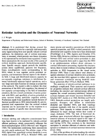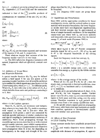
Introduction

Description



Discussion


Appendix 1


References

Biological Cybernetica, 62 289-298, 1990
It is postulated that during arousal the cortical system is driven by a spatially and temporally noisy signal arising from non-specific reticulo-cortical pathways. An elementary unit of cortical neuroanatomy is assumed, which permits non-linear dynamics to be represented by stochastic linear equations. Under these assumptions the resonant modes of the system of cortical dendrites approach thermodynamic equilibrium. Specific sensory signals perturb the dendritic system about equilibrium, generate low frequency, linear, non-dispersive waves corresponding to the EEG, which in turn regulate action potential sequences, and instantiate internal inputs to the dendritic field. A large and distributed memory capacity in axo-synaptic couplings, resistance to interference between functionally separate logical operations, and a very large next-state function set emerge as properties of the network. The model is able to explain the close association of the EEG with cognition, the channel of low capacity corresponding to the field of immediate attention, the low overall correlation of action potentials with EEG, and specificity of action potentials in some neurons during particular cognitive activity Predictions made from hypothesis include features of thermal equilibrium in EEG (determinable by autoregression) and expectation that the cortical evoked response can be accounted for as the response to a sensory impulse of specific time characteristics.
 Introduction |
 Description |
 |
 |
 Discussion |
 |
 Appendix 1 |
 |
 References |
 |